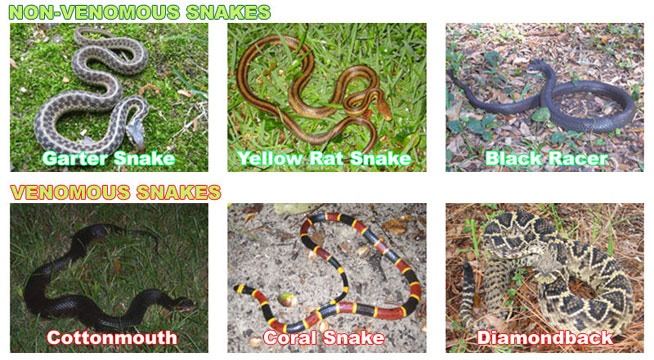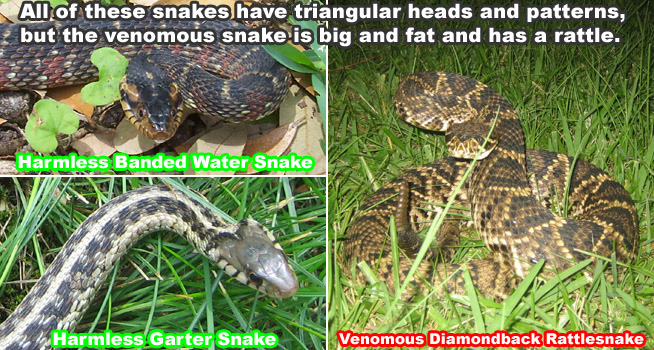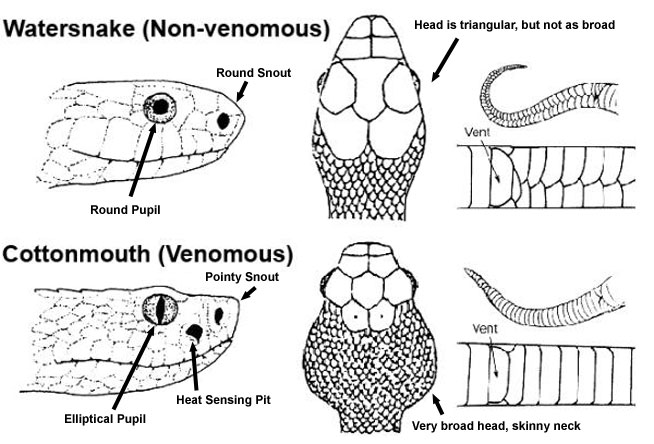There are no foolproof methods to always tell if a snake is venomous. Even harmless snakes have colors, triangular heads, and shake their tails. But a picture is worth a thousand words. Look at the below
photograph. You will see three of the most common snakes in Florida. First, a common Garter Snake, which is probably the most commonly seen snake in the United States. Next, a Yellow Rat Snake. The Red Rat Snake (corn snake) is
also super common in FL. Then a Black Racer, which is the most common snake of them all in FL. Just knowing these three species covers about 75% of snake sightings in Florida.

Now look at the snakes directly above, on the bottom half of the photo. The Cottonmouth, Coral Snake, and Diamondback. These are three of Florida's venomous snakes. Get to know what they look like, and voila, you've got a good clue about which snakes are dangerous. It's not hard, because there aren't many venomous species.

The triangular head test is worthless. Pretty much ALL snakes have triangular heads, from common Garter Snakes, to rat snakes, and water snakes. But the venomous snakes of the US and Florida are almost all pit vipers, and
these snakes are very fat. So if you see a super fat snake, then that's a good clue.

Here's a graph showing some more characteristics in more detail. But really, are you going to remember this stuff when you see a snake outside? Are you going to get close enough to look at the pupil shape? Are you going to pick
the snake up and check the dorsal vent? Nope. So just study photos of snakes if you want to be able to identify them, or better yet, when you see a snake, just leave it alone! This is a good policy whether the snake is venomous or not.
My information page about
The Venomous Snakes of Florida - with many photographs and info.
Read my article about
How to Identify Snakes - is the snake you saw dangerous or safe?
Here's my article about
Snake Bite First Aid Treatment - how to tell if it was venomous.
Here's my advice about
How to Kill Snakes - practical advice to best protect you.
Here are some photographs of venomous snakes:
Eastern Diamondback Rattlesnake
Eastern Coral Snake
Water Moccasin a.k.a.
Cottonmouth
Pygmy Rattlesnake
Timber Rattlesnake
Copperhead
How to tell if a snake is venomous
There are so many varieties of snake in the world, scientists have not yet categorized them all. They live all over the world, in different climates and regions. Some live near water, some in the desert, some prefer trees. Even though snakes are carnivorous, Their diets are just as varied. There are some that eat bugs, small animals, large animals, eggs, amphibians, and some eat other snakes. The size of the snake determines the size of its prey. One of the things they have in common is that they will strike if they feel threatened. While any snake bite can hurt, a bite from a poisonous snake can kill. Even though on 1/3 of all snakes in the world are poisonous, it still good to know which ones. As with anything, there are a few rare exceptions to the rules. Here are a few tips to help tell the difference between who’s harmless and who’s deadly.
Color - Most solid colored snakes are NOT poisonous. The rule In fact is usually the brighter the color, the more dangerous the snake.
Eyes - poisonous snakes usually have slitted pupils as opposed to round pupils
Head - The head of a venomous snake will be diamond shaped with a pointed snout.
Neck – Its head is very broad with a skinny neck
Shape – It is BIG and FAT
Tail – a poisonous snake’s tail is stubby and ends abruptly.
Some will have a small depression between the eye and nostril, gaining them the nickname “pit viper”. This is actually a heat sensing device to help it locate prey.
If you HEAR a rattle when a snake rattles it tail, it is a poisonous rattlesnake.
As mentioned before there are exceptions to every rule and these are only guidelines to snake identification. They best way to keep from getting bit is to pay attention to your surroundings. Don’t go into high grass and weeds barefooted or reaching with bare hands. Don’t antagonize a snake if you see one. Don’t try to catch or handle an unfamiliar snake! If you get bitten, try to ct the snake or have a good description of it, and call for medical help immediately!